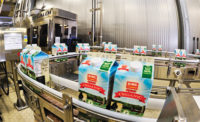Premium ingredients
Mars buys the cookies and brownies for the sandwiches and shortbread for the Twix Bars from outside sources because its competency is ice cream, not in baking, says Kim Latham, the Ice Cream Supply Director. The company buys ice cream mix from several regional suppliers in the Midwest who source milk from local farmers. Other ingredients, including the M&M’s chocolate candies obviously, come from Mars. Mars makes its own chocolate. It is in control of the process from “bean to bar,” says Laurie Winward, Director of Research and Development.
The processor makes its own caramel for its Milky Way, Snickers and Twix novelties. Winward says new hires in product development are taught how to make “a proper” caramel.
“We believe we make the best caramel in the industry, and we believe consumers can see and taste the difference,” Latham says. “As such, we make our own caramel from scratch in a controlled manner with rigid quality standards. It’s the care, time and precision that make the difference.”
The other signature ingredient in many products is the peanut. Mars sources these from Albany, Ga. These are the same peanuts used in Snickers candy bars. In Burr Ridge, Mars makes peanut butter from the peanuts and blends it into the ice cream mix used to make the Snickers Ice Cream Bars.
Dove Bar Ice Cream stick novelties used to be hand-dipped; now that process is automated. The ice cream bar line produces Dove Ice Cream Minis, Snickers, Twix and Milky Way Ice Cream bars. Thirty-six nozzles on the freezer extrude ice cream into continuous ropes. If the company is making Milky Way Ice Cream bars, then a second nozzle lays down a bead of caramel in an indentation on the top of the product. The extrusions, having the consistency of soft-serve ice cream, pass through a block-long tunnel freezer where the temperature is about minus 40˚F.
Upon exiting this freezer, the now rock-hard extrusions are guillotined into portions. The final bar size depends upon the product and retail channel. Items sold in boxes in grocery stores weigh a few ounces less than SKUs sold singly in convenience stores.
The portioned items are then conveyed to an enrobing station, essentially a shower of liquid chocolate. At the same time, the bars move through a chocolate bath to ensure coverage on the bottom. Next, the pieces are blast-frozen to harden the chocolate, and then they are conveyed to packaging.
There are multiple packaging lines, and sensors direct the bars to whichever line is available. Wrapped product is put into boxes which are conveyed to the secondary packaging station.
Mars processes milder flavors (vanilla) first and stronger ones (peppermint) last. Likewise, products containing peanuts or other allergens are processed after non-allergenic foods.















